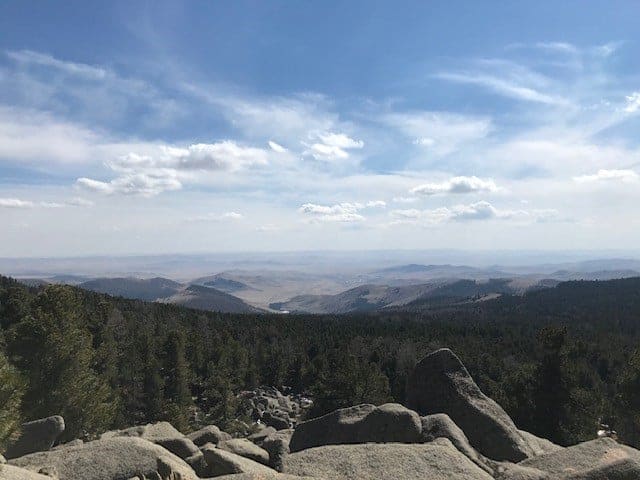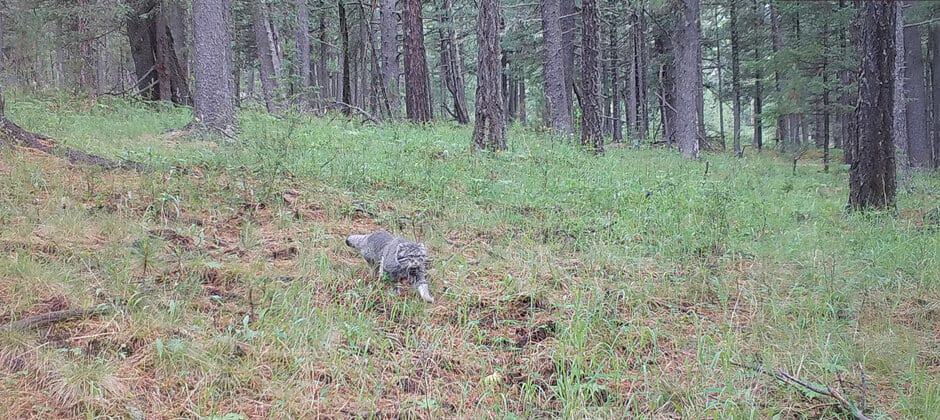Share this article
Wild Cam: Mongolian wolves, marmots and a feral dog challenge
The wild montane regions of Mongolia are home to a diverse group of mammals, including ibex, one of the largest marmot species on the planet, furry Pallas’s cats and corsac foxes. But some of these animals may be threatened by feral dogs from the nearby capital.
Bogdkhan Mountain Strictly Protected Area was designated as a UNESCO Biosphere Reserve in the 1990s. The area is a steppe zone, dominated by Bogdkhan mountain overlooking the capital to the north. The ridge is a sky island, providing a relatively isolated environment for some of the species that specialize in high altitude habitats.
“To get to that island, there is rolling steppe grass as far as you can see,” said TWS member Jeff Dolphin, a master’s student in zoology at the University of Wyoming.
Enlarge

Credit: Jeff Dolphin
The park has experienced some form of protection since the 12th century, when logging and other forms of resource extraction were prohibited. In 1809, the area was conserved by royal decree. “It’s arguably one of the oldest protected areas in the world,” Dolphin said. “That mountain is considered sacred by the culture.”
Researchers wanted to learn more about the mammal diversity in the Bogdkhan Mountain Strictly Protected Area just south of the nation’s capital Ulaanbaatar and how urbanization might be affecting it. The research was a collaborative effort between the conservation lab of Dolphin’s supervisor John Koprowski at the University of Wyoming and the Mammalian Ecology Lab of the Mongolian Academy of Sciences. They’ve been monitoring the animals there using trail cameras since April 2022.
In a research poster displayed at The Wildlife Society’s 2022 Annual Conference in Spokane, Dolphin presented the ongoing work he and his colleagues are conducting on mammals in the reserve.
Wolves and their descendants
As of December 2022, the cameras captured all 11 species previously recorded in the area.
One great capture so far is that of a breeding pair of wolves (Canis lupus), pups and a den. In Mongolia, wolves have a high cultural value, which could have implications for conservation. “It’s considered good luck to see a wolf, it’s considered even better luck to kill a wolf,” Dolphin said, paraphrasing an old Mongolian proverb he’s heard.
The researchers believe they have also captured significant numbers of additional wolves on camera, especially in parts of the reserve farther from the city. They also captured images of what appeared to be sarcoptic mange in some animals—in one case, it was so severe the wolf only retained a little hair on its back.
It isn’t clear if wolves are threatened in Mongolia, but another potential problem in Bogdkhan involves their cousins—feral and stray dogs (Canis familiaris), which they also captured on camera. The dogs likely live in the reserve in high numbers due to its proximity to the city.
“We didn’t know we were going to have such success getting wolves and dogs in Bogdkhan,” Dolphin said.
Enlarge

Credit: Koprowski Conservation Research Lab-Univ of Wyoming/Institute of Biology-Mongolian Academy of Sciences
The researchers are concerned about the possibility of hybridization where so many wolves and feral dogs overlap, though future investigation would be needed to better examine this issue.
Another potential issue with the feral dogs in the park is they prey on native wildlife. The researchers have captured video footage of feral dogs taking down a roe deer (Capreolus capreolus).
Red deer (Cervus elaphus), a close-relative of elk (Cervus canadensis) that resembles the latter’s size and bugle calls, also turned up on cameras. The team captured many images of both kinds of deer in Bogdkhan, as well as Eurasian boars (Sus scrofa).
“I’m shocked at the density of ungulates,” Dolphin said.
Marmots, felines and foxes
Enlarge

Credit: Maria Vittoria Mazzamuto
Dolphin’s work focused on the relationship between wolves and feral dogs in the park. But the cameras also captured footage of other mammals, including Mongolian marmots (Marmota sibirica), listed as endangered by the International Union for Conservation of Nature due to past overharvest.
They also captured nine Pallas’s cats (Otocolobus manul) on camera so far. Not much is known about these felines, though some work has been conducted elsewhere in Mongolia about the effect that livestock may have on them.
Enlarge

Credit: Koprowski Conservation Research Lab-Univ of Wyoming/Institute of Biology-Mongolian Academy of Sciences
Photos have also included another feline—the Eurasian lynx (Lynx lynx). This is the rarest animal researchers have captured images or footage of so far—they’ve only captured one instance of lynx.
The researchers also collected images of two species of foxes—corsac foxes (Vulpes corsac) and red foxes (Vulpes vulpes). One of the latter incidents involves two foxes jumping at each other playfully.
Enlarge

Credit: Koprowski Conservation Research Lab-Univ of Wyoming/Institute of Biology-Mongolian Academy of Sciences
Siberian ibex (Capra sibirica) showed up on camera a number of times—there appears to be a large herd that lives in Bogdkhan. These animals are the result of a reintroduced population in the area, and the cameras seem to indicate that the herd, recently counted at 100 individuals, is doing well in the area.
The work is ongoing, and the plans are to return to Mongolia in the upcoming spring and summer in the endeavor to build onto the collaboration with local researchers. But Dolphin said that so far, it appears like problems related to feral dogs, livestock encroachment and other human-caused issues are larger closer to Ulaanbaatar.
Header Image: A Pallas’s cat in Bogdkhan Mountain Strictly Protected Area near Ulaanbaatar. Credit: Koprowski Conservation Research Lab-Univ of Wyoming/Institute of Biology-Mongolian Academy of Sciences








